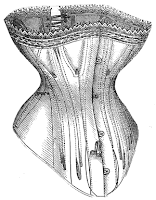Your hair is perfect; your makeup tasteful; your gown is a marvel of compromise between artistic expression and historical wonder. You are corseted, bustled, primped and beautiful. As you do one final check in the mirror you notice a tragedy; there is a wrinkle straight across your bodice. You smooth it out and head to the ball. As you twirl and dance, stroll and flirt you feel your skirts shifting. You step into the ladies room for an adjustment and it is back….that bothersome wrinkle, nearly dissecting your perfect silhouette in half. Your skirts have gotten a bit sideways, your bustle is no longer center and the euphoria of stepping from Romantic Victorian London has been shattered. Now you are just in another Halloween costume.
After all the planning, sweating, sewing and preparing, how could this happen? The answer is really quite simple, even if hard to believe. It is your corset.
If we think about this for a moment, it really is understandable. In your modern wardrobe, how many bras (or brassieres) do you own? Do you just have one that will work under anything? Why shouldn’t we assume that it was the same back when? If your corset is not creating the proper foundation how can we expect our labors of love to fit properly?
Following is a brief selection of corsets from varying years, even within the same year, many corsets had different overall shapes to help produce varying effects depending on the activities of the function it would be worn to and show how quickly the designs would change with fashion (pictures are of patterns reproduced by Ageless Patterns and are from original Harpers Bazaar and Le Mode newspapers):
1876 Short Striped Jean Corset
1876 White Coutil Corset
1877 White Jean Corset
1877 Coutil Spoonbill Corset
1886 Spoonbill Corset
1886 Lady's Gray Twill Corset
1888 Riding Corset of Gray Twill
1890 Twill Corset for Stout Lady
1891 Young Ladies Corset
1891 Lady's Riding Corset

1891 Corset for Elderly Lady

1893 Short Riding Corset

1893 Lady's Low Corset

1897 Corset for Stout Figure
When creating a period in clothing, it is always easier to start in the order we would dress.
Shift first – will it fit with the time? Will it be visible under our planned garment? Will it be comfortable under all those layers?
Then we would put on our corset – Is the line correct? I.e. does it mirror the shape that we wish our bodice to have? Where is the waist? Does it smooth over the hips for late Victorian; does it bring the waist high and tight like civil war?
Crinoline, bustle petticoat etc. – Will bones show through? Does it hold the gowns shape at the bottom hem? And most importantly – Can we sit, dance, walk and move with natural ease?
Skirts – will they stay where put? In the late Victorian era, these were meant to sit on the hips instead of at the waist to allow the long torso to be displayed. To keep them in place, small hooks were attached to the corset that would hold the skirts in their position and prevent them riding high to the waist, which is where skirts sat just earlier for civil war.
Bodice – the last and most certainly not least. It should be smooth (unless rouched by design), it should be flattering, and it should hide all the layers of undergarments making one wonder if there really is a corset under all that.
With all the consideration we give our gowns through color, cut, decoration, and accessories, we must give that same amount to all the aspects that will not be seen. The foundation of our garments is just as important to style as a solid foundation is to a house. Don’t skimp, or it could all come down around you!
Happy Stitching!










No comments:
Post a Comment